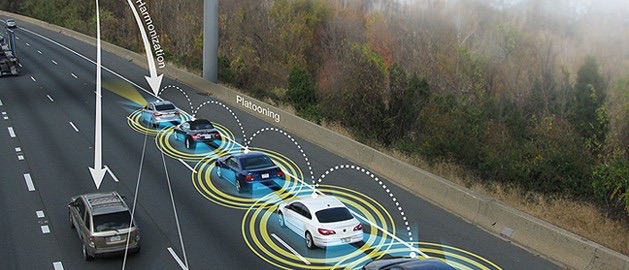
Cyber Physical Systems
safety, security and privacy
Cyber-physical systems (CPSs) represent a class of networked control systems with vast and promising applications. This class may include for instance smart cities, intelligent transportation systems based on fleets of cooperative and autonomous vehicles or distributed sensing and control solutions that leverage Internet-of-Things (IoT) devices. As a common trait, these systems are expected to provide important functionalities that may positively influence our life and society. However, said positive outcomes may be hindered by novel threats to the safety of CPSs, such as malicious cyber-attacks that could negatively affect the physical domain. Furthermore, the sheer amount of data gathered, exchanged and processed by those architectures are going to pose fundamental societal interrogatives regarding privacy and confidentiality, and the fair use of such data (missing reference). Prevention, resilience and detection are key functionalities through which we can avoid that attacks in the cyber domain lead to loss of safety in the physical one.
We contributed to the problem of detecting stealthy cyber attacks in networked control systems by proposing a multiplicative sensor watermarking technique (Ferrari & Teixeira, 2021; Gallo et al., 2021). By taking inspiration from lightweight authentication techniques, we introduce a deterministic distortion into data sent by sensors to the controller, which is unknown to the attacker. This leads to a knowledge imbalance between an eavesdropping attacker and a defender, where the latter can use knowledge of the watermark and a model-based residual generator to detect otherwise stealthy attacks such as rerouting (Ferrari & Teixeira, 2017), replay (Ferrari & Teixeira, 2017) and zero-dynamics (Teixeira & Ferrari, 2018) injection ones. Differently than physical watermarking, our approach allows for perfect watermarking removal at controller level, thus unaffecting control performances.
We further explored the use of Differential Privacy (Dwork & Roth, 2014) to allow for privacy preserving distributed state estimation and anomaly detection, thus preventing the leakage of private data by eavesdroppers or by curious, although not necessarily malicious, third parties (Rostampour et al., 2018; Rostampour et al., 2020). Currently we are working towards fast, real time implementations of Fully Homomorphic Encryption schemes as a tool to guarantee confidentiality and integrity in a much more robust, albeit computationally expensive way (Gentry et al., 2013).
Joint work with (mostly): André Teixeira, Twan Keijzer, Alex Gallo, Vahab Rostampour.
Publications
- ACM_TCPSSwitched Zero Dynamics Attacks on Sampled-Data Systems with Non-Uniform Sampling: Vulnerability and CountermeasuresACM Transactions on Cyber-Physical Systems 2025
- AUTO
- IEEE_LCSSPeriodic sparse control to prevent undetectable attacks on over-actuated systemsIEEE Control Systems Letters 2025
- IEEE_TACOn the Output Redundancy of LTI Systems: A Geometric Approach With Application to PrivacyIEEE Transactions on Automatic Control 2025
- IEEE_TITSCollaborative Vehicle Platoons With Guaranteed Safety Against Cyber-AttacksIEEE Transactions on Intelligent Transportation Systems 2024
- IEEE_LCSSSecure State Estimation under Actuator and Sensor Attacks using Sliding Mode ObserversIEEE Control Systems Letters 2023
- IEEE_TACPrivatized distributed anomaly detection for large-scale nonlinear uncertain systemsIEEE Transactions on Automatic Control 2020
- IEEE_TACA Switching Multiplicative Watermarking Scheme for Detection of Stealthy Cyber-AttacksIEEE Transactions on Automatic Control 2021
- ECC25Zero Dynamics Attacks Subject to Actuator Saturation: A Constrained Optimization ApproachIn European Control Conference 2025
- CDC24A Self-Triggered Control Watermarking Scheme for Detecting Replay AttacksIn 2024 IEEE 63rd Conference on Decision and Control (CDC) 2024
- CDC23Secure State Estimation under Actuator and Sensor Attacks using Sliding Mode ObserversIn Conference on Decision and Control 2023
- CDC21Design of multiplicative watermarking against covert attacksIn Conference on Decision and Control 2021
- CDC19A Sliding Mode Observer Approach for Attack Detection and Estimation in Autonomous Vehicle Platoons using Event Triggered CommunicationIn Conference on Decision and Control 2019
- NECSYS19Privacy-Preserving of System Model with Perturbed State Trajectories Using Differential Privacy: With Application to a Supply Chain NetworkIn IFAC Workshop on Distributed Estimation and Control in Networked Systems 2019
- SAFEPROCESS18Differentially-Private Distributed Fault Diagnosis for Large-Scale Nonlinear Uncertain SystemsIn IFAC Symposium on Fault Detection, Supervision and Safety for Technical Processes 2018
- NECSYS18Attack Detection and Estimation in Cooperative Vehicles Platoons: A Sliding Mode Observer ApproachIn IFAC Workshop on Distributed Estimation and Control in Networked Systems 2018
- ECC18Detection of Sensor Data Injection Attacks with Multiplicative Watermarking2018
- IFAC17Detection and Isolation of Replay Attacks through Sensor Watermarking2017
- IFAC17A Message Passing Algorithm for Automatic Synthesis of Probabilistic Fault Detectors from Building Automation OntologiesIn IFAC World Congress 2017
- ACC17Detection and isolation of routing attacks through sensor watermarkingIn American Control Conference 2017
- SPRINGER
- SPRINGER
- SPRINGERDetection of Cyber-Attacks: a Multiplicative Watermarking SchemeIn Safety, security, and privacy for cyber-physical systems, Springer 2021
- SPRINGERDifferentially Private Anomaly Detection for Interconnected SystemsIn Safety, security, and privacy for cyber-physical systems, Springer 2021
- SPRINGER
Additional References
- The Algorithmic Foundations of Differential PrivacyNow Publishers 2014
- Homomorphic Encryption from Learning with Errors: Conceptually-Simpler, Asymptotically-Faster, Attribute-BasedIn Advances in Cryptology – CRYPTO 2013 2013